
Santiago de Compostela or Compostela is the capital of the autonomous community of Galicia, in northwestern Spain. The city has its origin in the shrine of Saint James the Great, now the Cathedral of Santiago de Compostela, as the destination of the Way of St. James, a leading Catholic pilgrimage route since the 9th century. In 1985, the city's Old Town was designated a UNESCO World Heritage Site.

Ferdinand II, was a member of the Castilian cadet branch of the House of Ivrea and King of León and Galicia from 1157 until his death.

James the Great was one of the Twelve Apostles of Jesus. According to the New Testament, he was the second of the apostles to die, and the first to be martyred. Saint James is the patron saint of Spain and, according to tradition, his remains are held in Santiago de Compostela in Galicia. He is also known as James, son of Zebedee, Saint James the Great, Saint James the Greater, Saint James the Elder, or Saint Jacob.
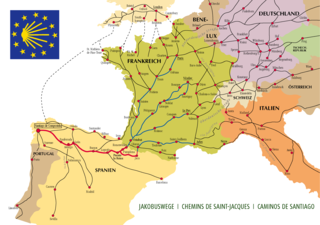
The Camino de Santiago, or in English the Way of St. James, is a network of pilgrims' ways or pilgrimages leading to the shrine of the apostle James in the cathedral of Santiago de Compostela in Galicia in northwestern Spain, where tradition holds that the remains of the apostle are buried.
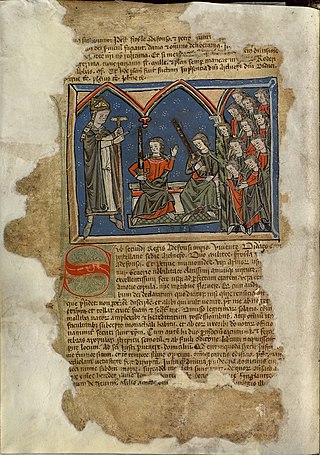
Diego Gelmírez or Xelmírez was the second bishop and first archbishop of the Catholic Archdiocese of Santiago de Compostela in Galicia, modern Spain. He is a prominent figure in the history of Galicia and an important historiographer of the Iberia of his day. Diego involved himself in many quarrels, ecclesiastical and secular, which were recounted in the Historia Compostelana, which covered his episcopacy from 1100 to 1139 and serves as a sort of gesta of the bishop's life.

The Santiago de Compostela Archcathedral Basilica is part of the Metropolitan Archdiocese of Santiago de Compostela and is an integral component of the Santiago de Compostela World Heritage Site in Galicia, Spain. The cathedral is the reputed burial place of Saint James the Great, one of the apostles of Jesus Christ. It is also among the remaining churches in the world built over the tomb of an apostle, the other ones being St Peter's Basilica in Vatican City, St Thomas Cathedral Basilica in Chennai, India and Basilica of St. John in Izmir, Turkey.
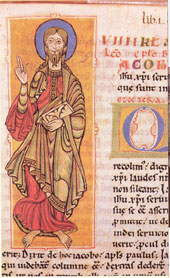
The Codex Calixtinus is a manuscript that is the main witness for the 12th-century Liber Sancti Jacobi, a pseudepigraph attributed to Pope Calixtus II. The principal author or compiler of the Liber is thus referred to as "Pseudo-Calixtus", but is often identified with the French scholar Aymeric Picaud. Its most likely period of compilation is 1138–1145.

Beatriz Pereira de Alvim (1380–1414) was a Portuguese noblewoman, the only child of Nuno Álvares Pereira and his wife Leonor de Alvim.

The Milky Way is a 1969 comedy-drama film directed by Luis Buñuel. It stars Laurent Terzieff, Paul Frankeur, Delphine Seyrig, Georges Marchal and Michel Piccoli. Buñuel later called The Milky Way the first in a trilogy about "the search for truth."

Bona of Pisa was a member of the Third order of the Augustinian nuns who helped lead travellers on pilgrimages. In 1962, she was canonized a saint in the Catholic Church by Pope John XXIII. She is considered the patron saint of travellers, and specifically couriers, guides, pilgrims, flight attendants, and the city of Pisa.
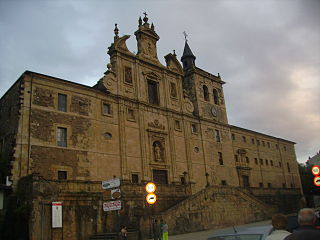
Villafranca del Bierzo is a village and municipality located in the comarca of El Bierzo, in the province of León, Castile and León, Spain.

Christianity has a strong tradition of pilgrimages, both to sites relevant to the New Testament narrative and to sites associated with later saints or miracles.
Verano del '98 is an Argentine telenovela intended for teenagers, broadcast by Telefe from January 26, 1998 until November 24, 2000. Allegedly planned as way to cover a programming gap for the summer of 1998, it became such a hit that it ended lasting three consecutive seasons. After the series aired Telefe came under fire as it became apparent that Verano del '98 was a thinly veiled copy of the popular American teen drama Dawson's Creek, which also started airing around the same time. Gustavo Yankelevich, Telefe's chief artistic director, admitted having attended an early screening of Dawson's Creek in 1997 but thought Sony had lost interest in the project and decided to use it as inspiration when developing Verano del '98. Sony and Telefe settled out of court.
Berengaria of León was the third wife but only empress consort of John of Brienne, Latin Emperor of Constantinople. She was a daughter of Alfonso IX of León and Berengaria of Castile. She was a younger sister of Ferdinand III of Castile and Alfonso of Molina.
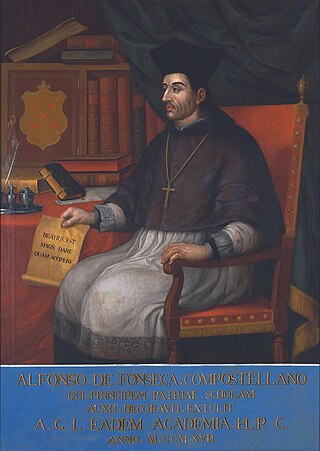
Alonso III Fonseca was a Galician archbishop and politician. He was archbishop of Santiago de Compostela from 1507, and archbishop of Toledo from 1523. He was a major supporter of the University of Santiago de Compostela. He was the son of the archbishop Alonso II Fonseca and Alonso II's concubine María de Ulloa.

Pedro Fróilaz de Traba was the most powerful secular magnate in the Kingdom of Galicia during the first quarter of the twelfth century. According to the Historia compostelana, he was "spirited ... warlike ... of great power ... a man who feared God and hated iniquity," for Diego Gelmírez himself had "fed him, like a spiritual son, with the nutriment of holy teaching." Brought up at the court of the Emperor Alfonso VI, Pedro raised the future Emperor Alfonso VII in his household. Around the latter he and Diego formed a "Galician party" that dominated that region during the turbulent reign of Urraca (1109–26). In September 1111 they even had the child Alfonso crowned king at Santiago de Compostela, but it was Pedro who was imperator in orbe Galletiae.

Pilgrim badges are decorations worn by some of those who undertake a Christian pilgrimage to a place considered holy by the Church. They became very popular among Catholics in the later medieval period. Typically made of lead alloy, they were sold as souvenirs at sites of Christian pilgrimage and bear imagery relating to the saint venerated there. The production of pilgrim badges flourished in the Middle Ages in Europe, particularly in the 14th and 15th centuries, but declined after the Protestant Reformation of the mid-16th century. Tens of thousands have been found since the mid-19th century, predominantly in rivers. Together they form the largest corpus of medieval art objects to survive to us today.

Sueña conmigo is an original telenovela produced by Nickelodeon Latin America, Illusion Studios and Televisa. This is the 5th Latin American production for Nickelodeon. The first announcement was after the last episode of the telenovela of the same channel Isa TK+. In Hispanic America, the sneak preview was on July 20, 2010, the official release was on August 23, 2010.

Pedro Fernández de Castro, nicknamed el de la Guerra, was a powerful Galician noble and military figure of the House of Castro, descended by illegitimate lines from the kings of Castile-Leon-Galicia. Pedro Fernandez de Castro was Lord (Señor) of Lemos and Sarria and served as mayordomo mayor of Alfonso XI of Castile, adelantado de la frontera (governor) of Andalusia, Galicia and Murcia and pertiguero mayor of the lands of Santiago.
El secreto de Puente Viejo is a Spanish soap opera produced by Boomerang TV that originally aired from 23 February 2011 to 20 May 2020 on Antena 3.
















